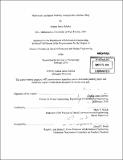| dc.contributor.advisor | Mark S. Welsh. | en_US |
| dc.contributor.author | Jahnke, Joshua James | en_US |
| dc.contributor.other | Massachusetts Institute of Technology. Dept. of Mechanical Engineering. | en_US |
| dc.date.accessioned | 2010-10-05T14:33:47Z | |
| dc.date.available | 2010-10-05T14:33:47Z | |
| dc.date.copyright | 2010 | en_US |
| dc.date.issued | 2010 | en_US |
| dc.identifier.uri | http://hdl.handle.net/1721.1/58868 | |
| dc.description | Thesis (S.M. in Naval Architecture and Marine Engineering)--Massachusetts Institute of Technology, Dept. of Mechanical Engineering, 2010. | en_US |
| dc.description | Cataloged from PDF version of thesis. | en_US |
| dc.description | Includes bibliographical references (p. 53). | en_US |
| dc.description.abstract | Ship's lines are designed such that they are fair. To the naval architect, fairness means that the lines exhibit a continuous second derivative. This is the definition of a spline. Before the advent of digital computers, naval architects checked every line on a lines plan for fairness by bending a thin stick of wood, called a batten, on the line. If the line followed the natural bend of the batten, the line was fair. This phenomenon follows from the beam equation, which shows that the minimum energy in the beam occurs when the beam has a continuous second derivative of position. Hydrostatics lies at the heart of naval architecture. The hydrostatic properties of a hull are determined by the lines and their interpretation using rules of integration. The resulting analysis is presented in the form of graphs, termed the "curves of form" or "displacement and other curves." An intact stability analysis follows naturally from the hydrostatic analysis. Hydrostatics (determination of KM) coupled with a KG value can be used to predict initial stability. This intact stability analysis evaluates the range of stability at both small and large angles of inclination. The responses of the hull to static and dynamic loading situations can be inferred from the curves of form. Their most basic use is to determine the static waterline in various loading scenarios. A more subtle use is to determine the correct placement of the vertical center of gravity to ensure a sea kindly roll period, stability in beam winds, and stability in high speed turns. Various computational tools can be used to compute the hydrostatic and stability properties of a ship. This thesis explores the results from two computer aided design tools used by the U.S. Navy and commercial industry; Advanced Surface Ship and Submarine Evaluation Tool (ASSET) and Program for Operational Ship Salvage Engineering (POSSE). | en_US |
| dc.description.statementofresponsibility | by Joshua James Jahnke. | en_US |
| dc.format.extent | 96 p. | en_US |
| dc.language.iso | eng | en_US |
| dc.publisher | Massachusetts Institute of Technology | en_US |
| dc.rights | M.I.T. theses are protected by
copyright. They may be viewed from this source for any purpose, but
reproduction or distribution in any format is prohibited without written
permission. See provided URL for inquiries about permission. | en_US |
| dc.rights.uri | http://dspace.mit.edu/handle/1721.1/7582 | en_US |
| dc.subject | Mechanical Engineering. Center for Ocean Engineering. | en_US |
| dc.subject | Mechanical Engineering. | en_US |
| dc.title | Hydrostatic and intact stability analysis for a surface ship | en_US |
| dc.type | Thesis | en_US |
| dc.description.degree | S.M.in Naval Architecture and Marine Engineering | en_US |
| dc.contributor.department | Massachusetts Institute of Technology. Center for Ocean Engineering | en_US |
| dc.contributor.department | Massachusetts Institute of Technology. Department of Mechanical Engineering | |
| dc.identifier.oclc | 650308396 | en_US |
